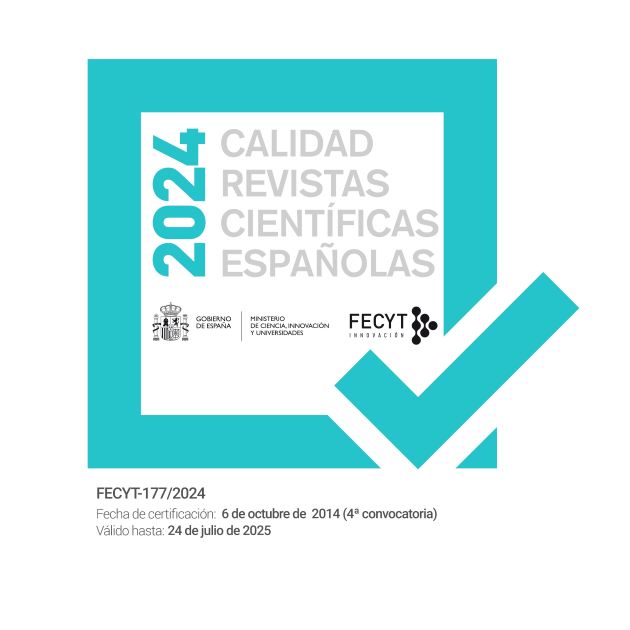Publication standards
1. Formal rules of presentation
In accordance with the quality criteria required both by ISI (Institute for Scientific Information) databases, and in order to be included in the Journal Citation Reports (JCR), the following standards for publication of papers in the RCDI are established as mandatory.
1.1. Author:
Papers submitted for publication in RCDI may not include authorship data within the text of the paper, so that the blind evaluation process can be carried out, according to the journal's own protocol.
In the user registration form, which must be completed by each contributor, the author's personal and academic details will be included, which will appear in the text that is finally published.
1.2. Heading:
At the beginning of all work, the following data must be recorded:
- Title of the work, in lower case, which must faithfully reflect the content of the article, in Spanish and English.
- Next, the authorship will be collected as explained in 1.1.
- Abstract of the article with a maximum of 250 words.
- Summary of the article in English (abstract).
- Keywords: 5 to 10 keywords.
- Key words in English.
1.3. Extension:
- The STUDIES will have a length between 25 to 40 pages.
- OPINIONS and NOTES, from 10 to 25 pages.
- JURISPRUDENTIAL STUDIES, from 10 to 20 pages.
- BIBLIOGRAPHICAL REVIEWS, 2 to 4 pages.
1.4. Tipo de letra:
- Word processing: Word.
- Font: Times New Roman. No bold or underlining. Italics are permitted.
- Size:
- Article text: 12 points
- text of Notes: 10 points
- text of the Titles: 14 points
- Single spacing.
- Paragraph alignmet: right and left justified.
1.5 Structure of the work:
- In addition to the heading, all should contain a SUMMARY at the beginning, which should follow the following guidelines:
I.- IN VERSALS.
II.- 1. ON VERSALITES.
III.- 1. A. In italics.
IV.- 1. A. a) In the round.
V.- 1. A. a) a´) (if any). - In round.
It will end with brief CONCLUSIONS, which should be preceded by a Roman numeral.
I.- […]
II.- […]
III.- […]
An INDEX of the resolutions cited throughout the work will be added at the end of the work, always in connection with the topic. Said appointment will be made with the following scheme:
Eg. STS of October 22, 2002. (Without points in the initials).
Finally, it will have a BIBLIOGRAPHY section, which will collect the bibliographic references in alphabetical order, according to the form expressed in the following section.
2. Rules for the preparation of bibliographic references
For the enumeration of the specific BIBLIOGRAPHY on the subject treated, and for the NOTES at the end of the paper, the following APA (American Psychological Association) format standards, contained in the Manual of Style, will be followed: Manual de publicaciones de la Asociación Americana de Psicología, available at www.apastyle.org.
- Book:
SURNAME, Initial of the name. Year (in parentheses). Title of the work in italics. Place of publication: Editorial.
Example: GÓMEZ GÁLLIGO, J. (2000). Lessons in Mortgage Law. Madrid: Marcial Pons.
- Chapter of the book:
SURNAME, Initial of the name. Year (in parentheses). Chapter title. In: Initial Name and Surname (ed./adir./coord.), Book Title (in italics). City: Editorial (initial and final pp.).
Example: DIAZ FRAILE, JM (2017). Commentary on the ruling of the Supreme Court of January 13, 2015. In M. Yzquierdo Tolsada (dir.). Comments on the rulings of unification of doctrine (Civil and Commercial) Vol. 7º (2015). Madrid: Dykinson, BOE, Colegio de Registradores de España (pp. 47-63)
- Article:
SURNAME, Initial of Name. Year (in parentheses). Article title. Name of the Magazine in italics, number of the magazine, initial and final pages.
Example: GÓMEZ PÉREZ, A. (1969). Los alimentos debidos a la viuda encinta. Revista General de Legislación y Jurisprudencia, núm. 2, 373-401.
- Electronic document:
In addition to what is indicated above depending on whether it is a book or an article, you must indicate [Online], the URL and the date of publication or the date of its most recent update.
Example: GÓMEZ POMAR, F. (2001). Burden of proof and strict liability. InDret [Online], no. 40, available at http://www.indret.com/cas/artdet.php?Idioma=cas&IdArticulo=139
It should be remembered that the form of citing in the text corresponding to the APA standards varies with respect to the traditional one so that:
In the case of bibliographical references in text, they are introduced in the text itself as follows: (author, year of publication and page). The complete citation is developed according to the rules just described in the bibliography at the end of the article, not at the foot of the page.
Example: La viuda encinta se hace merecedora de los alimentos (GÓMEZ PÉREZ, 1969, 373), por lo que sería conveniente…
Both the citations with bibliographic reference and the Notes that are clarifying or informative, will always go at the end of the article, consecutively numbered and not on the page where the appointment corresponds.
3.Other style rules
3.1. Citation os legal norms:
The first citation of a standard, in the text, will be complete.
For example: Law 15/2015, of July 2, on Voluntary Jurisdiction (hereinafter, LJV or Law 15/2015).
The terms "Spanish Constitution", "Civil Code", "Commercial Code", "article", "paragraph", "number", "provision", etc. They will be written completely in the text, unless it is in parentheses or in square brackets, in which case the abbreviation (CE, CC, CCo, art., pfo., no., disp.) can be used.
3.2. Capitalization:
It is convenient to use lowercase letters in the initials of positions or offices (registrar, notary, lawyer ...), organs (court, court ...), precepts (article, decree ...), leaving the use of capital letters initial for the names of people and institutions (Provincial Court, Commercial Court, Property Registry ...) and for the titles of the regulations.
The Editorial and Editorial Board of the Revista Crítica de Derecho Inmobiliario will reject papers that do not comply with the publication standards indicated.





